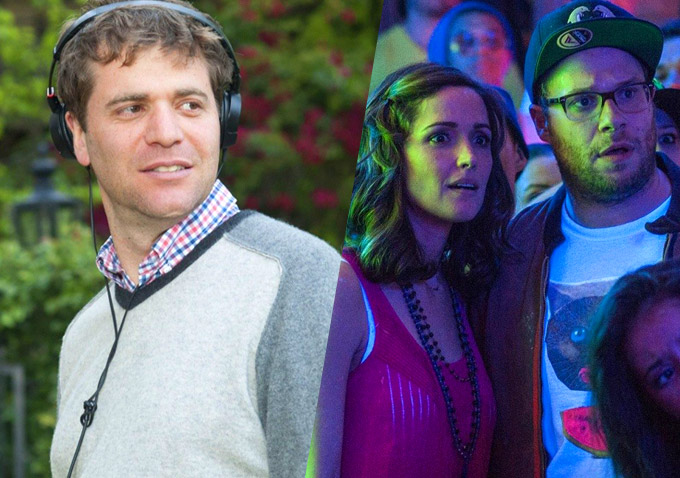
Director Nicholas Stoller has steadily been rising in the ranks, having worked for many years under Judd Apatow on everything from “Undeclared” to a string of successful studio comedies, including “Forgetting Sarah Marshall” and 2012’s “The Five-Year Engagement.” (He was also involved with both of Disney’s recent Muppets movies.) But Stoller is about to break into the big leagues with this weekend’s gut-busting “Neighbors” (review here), a film that pits Seth Rogen’s new dad against Zac Efron’s rowdy frat leader in a war for suburban supremacy. We recently sat down with Stoller and chatted about the five biggest influences on his new film, most of which will be very surprising (especially for those that have already seen the film).
When “Neighbors” premiered at South by Southwest, Stoller openly admitted that one of the biggest influences for the movie was “Enter the Void,” Gaspar Noe’s neon-lit nightmare set in an otherworldly Tokyo. We asked Stoller to elaborate on this during our chat. “Both ‘Enter the Void’ and ‘Spring Breakers‘ were big influences, although ‘Enter the Void’ was the one I pulled apart, mostly for the lighting,” Stoller said. In fact, there was a giant homage to the movie that was ultimately left on the cutting room floor. “We actually did a sequence with one camera move that was very ‘Enter the Void’-like. It was the introduction to the frat guys and we follow Zac around the house and every room had different lighting and different sound and it was all in one shot,” Stoller explained. “And I ended up covering it in different shots just to be safe and we ended up using that. But taken by itself it’s a pretty awesome, funny, cool sequence.”
Another influence, and probably the most obvious choice of the bunch, was John Landis’ classic “Animal House,” arguably the gold standard for which all rowdy frat comedies aspire. Stoller had a very specific angle for his reference, though. “I’ve watched it eight zillion times like everyone else in comedy but what I took from that is that you love the frat guys in the movie and you want to be a part of that group,” Stoller said. “It was important to me to have our frat guys be really nice in addition to being super funny. So we cast everyone to be really nice guys, most importantly.” It was a deliberate attempt to stay away from the lazy approach of making them irreproachable assholes. “The easiest thing in the world is to vilify a frat house; maybe it’s slightly easier to vilify the Ku Klux Klan. It’s very easy to go there,” Stoller explained. “But I didn’t want them to be villains I just wanted them to be guys who were in their 20s who want to party. There were actors who came in who just seemed douche-y and I didn’t want that vibe.”
Stoller then threw out another curveball citing Steven Soderbergh‘s “Ocean’s Eleven” as an influence. “The middle (the black light party) and the end are dumb heists, and they’re structured like dumb heists. And I wanted them to feel, besides being funny, to feel tense,” Stoller told us. “I wanted the audience to be as much on the edge of their seat as they can for a sequence like that when they’re putting bros before hoes. It sounds ridiculous when I say it but that’s why I watched ‘Ocean’s Eleven’ and pulled apart those sequences. I wanted to tell those sequences visually. And little things that end up taking a lot of time and effort but hopefully go down smooth. Stuff as small as the fact that we don’t talk about the fireworks and the fuse box in Teddy’s room, it’s all just laid in visually.” These are things, he says, that he took from Soderbergh’s approach. “I learned that from ‘Ocean’s Eleven’ and how Soderbergh just lays that in visually,” he said. Then Stoller threw out a couple more references that are, at least spiritually, in the same wheelhouse. “In the same way ‘The Conversation‘ and ‘Rear Window‘ became references because of all of the point-of-view shots; there’s a billion point-of-view shots in this movie and a lot of weird slow seventies push-ins.”
Another, more recent reference point was the rambunctious, found footage high school party movie “Project X.” “We just ripped off all of the found footage stuff,” Stoller said very matter-of-factly. “And I watched that movie a lot – it just looks awesome. So I just watched that to see how that party felt so epic. Part of it was a billion pieces of footage. So we shot a lot of that stuff for this movie.”
The last reference point came after the fact, according to Stoller: Martin Scorsese’s 1991 remake of J. Lee Thompson’s 1962 psychological thriller “Cape Fear.” “This was one I only noticed retroactively but Zac Efron is kind of in that mold,” Stoller said, before adding: “It’s a certain kind of performance. And he’s always built and shirtless and scary.”
“Neighbors” opens everywhere today.

